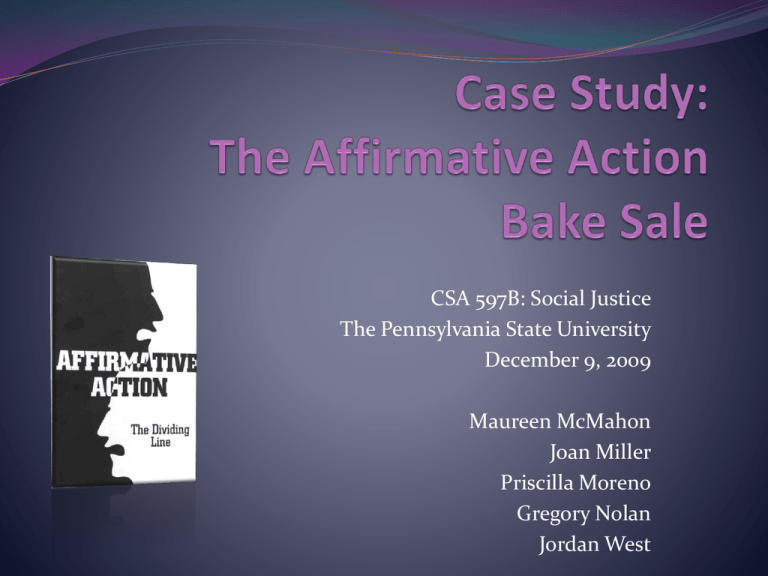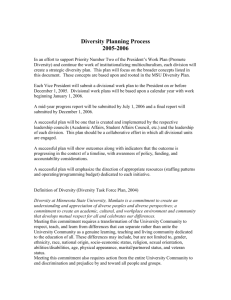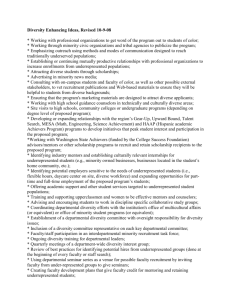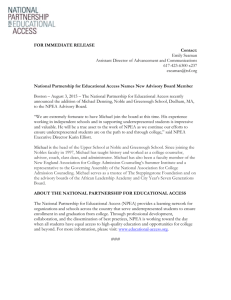Case Study Presentation
advertisement

CSA 597B: Social Justice The Pennsylvania State University December 9, 2009 Maureen McMahon Joan Miller Priscilla Moreno Gregory Nolan Jordan West Issues •Racism •Privilege •Communication •Conflict •University Value •Safety Relevant Theories White Identity Development - Helms Phinney's Identity Development for Students of Color Critical Race Theory Student Engagement Theory - Chickering's Vectors Salient Vectors Developing Competence Managing Emotions Developing Mature Relationships Establish Identity Develop Integrity Interventions •Leadership Retreat •Commission for Racial/Ethnic Diversity •Open Forums •Campus Speakers •Incident Report Clarity •Clarity on Importance of MSRW •Informal Interactions Leadership Retreat Potential Outcome Discussion/Problem identification Definition of diversity education for Elite University Goals/objectives for developing cultural competencies Unanticipated Consequences Blame; continuation of stereotyping Further division In order for multicultural education to be successful, faculty, staff and administrators must agree on a common language and define what multiculturalism means for their particular campus. There must also be some agreement on what knowledge, skills, and attitudes students should possess in order to be considered culturally competent in a diverse environment. (Howard-Hamilton, Richardson, & Shuford, 1998) Commission for Racial/Ethnic Diversity Potential Outcomes Assessment of campus climate in areas of diversity Development of a university wide plan for diversity education grounded in Elite’s philosophy and mission Unanticipated Consequences Loss of faculty unwilling to accept change Loss of financial support from disgruntled alumni/parents Both the theory and findings indicate that individual students benefit when they are engaged with diverse peers; however, as a society we have provided no template for interaction across racial/ethnic groups and such interaction cannot be taken for granted in the college environment. (Gurin, Dey, Hurtado & Gurin, 2002) Becoming culturally competent is a journey that is fraught with detours and hazards; however, having a well drawn and usable road map and recognizing the landmarks along the way will help make the journey a successful one. (Talbot, 1996, p.31) Open Forums/Speakers Potential Outcomes Unanticipated Consequences Shift in student attitude toward the benefits of a diverse climate Improvement in moral identity development; perspective taking. Elite times may begin to report positive news of underrepresented population Increase in arguments and altercations Colleges that diversify their student bodies and institute policies that foster genuine interaction across race and ethnicity provide the first opportunity for many students to learn from peers with different cultures, values and experiences. Genuine interaction goes beyond mere contact and includes learning about difference in background, experience, and perspectives, as well as, getting to know one another individually. (Gurin, Dey, Hurtado, & Gurin, 2002) Incident Report Clarity Potential Outcomes Unanticipated Consequences Increased support/vigilance from Campus Police Less altercations/incidents of bias related crime Increased incidence of bias related situations Further concern expressed by faculty, parents and alumni Clarity in Purpose of MSRW Potential Outcomes Structural diversity Unanticipated Consequences Ridicule from individuals Benefits of a diverse population for all students opposed to recruitment Continued lack of faculty Increased faculty support commitment Structural diversity is a necessary but insufficient condition for maximal educational benefits; therefore, the theory that guides our study is based on students’ actual engagement with diverse peers. (Gurin, Dey, Hurtado & Gurin, 2002) The presence of racially underrepresented students appears to contribute to the total institutional environment and particularly to the education of white students. Increasing the numbers of students of color on campus not only expands opportunities for students of color who enroll, but also enhances the educational experiences of white students. (Astin & Chang, 1997) Opportunities to foster informal interaction/volunteerism Potential Outcomes Unanticipated Consequences Faculty and majority students experience dissonance/disequilibrium Change in values/attitudes of faculty and white students Escalation in type of bias related incidents due to fear of change When volunteer groups are diverse , the members tend to not only develop altruism, but human understanding and knowledge of other cultures. This kind of experiential learning can affect real attitudinal changes for faculty, students and administrators. Each group is provided a window of opportunity to develop new appreciation and values for the other. (Howard-Hamilton, Richardson & Shuford, 1998) Recruitment and Retention of Underrepresented Students Overall pushback against using affirmative action States that have banned affirmative action California (1996) Texas (1996-97) Washington (1998) Florida (2000) Michigan (2006) Nebraska (2008) Recruitment and Retention of Underrepresented Students What Elite University can do… Recruitment: Work with high school students Ensure all-inclusive Provide Form marketing materials funding for underrepresented students partnerships with HBCUs Have a minority presence on campus Recruitment and Retention of Underrepresented Students What Elite University can do: Retention: Support advocacy units Provide educational opportunities for current students Questions?





